
Illustrative Math Alignment: Grade 6 Unit 1
Dividing Fractions
Lesson 15: Volume of Prisms
Use the following Media4Math resources with this Illustrative Math lesson.
| Thumbnail Image | Title | Body | Curriculum Nodes |
|---|---|---|---|

|
Video Transcript: Geometry Applications--Volume of a Pyramid | Video Transcript: Geometry Applications--Volume of a Pyramid
This is the transcript for video entitled: "Geometry Applications--Volume of a Pyramid." This is part of a collection of video transcript from the Geometry Applications video series. To see the complete collection of transcripts, click on this link. Note: The download is a PDF file. Video Transcript LibraryTo see the complete collection of video transcriptsy, click on this link. Video LibraryTo see the complete collection of videos in the Video Library, click on this link. |
Pyramids |

|
Video Transcript: Geometry Applications--Volume of a Pyramid | Video Transcript: Geometry Applications--Volume of a Pyramid
This is the transcript for video entitled: "Geometry Applications--Volume of a Pyramid." This is part of a collection of video transcript from the Geometry Applications video series. To see the complete collection of transcripts, click on this link. Note: The download is a PDF file. Video Transcript LibraryTo see the complete collection of video transcriptsy, click on this link. Video LibraryTo see the complete collection of videos in the Video Library, click on this link. |
Pyramids |
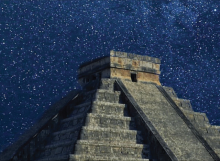
|
VIDEO: Geometry Applications: 3D Geometry, Pyramid Volume | VIDEO: Geometry Applications: 3D Geometry, Pyramid Volume
Topic3D Geometry |
Pyramids |

|
VIDEO: Geometry Applications: 3D Geometry, Pyramid Volume | VIDEO: Geometry Applications: 3D Geometry, Pyramid Volume
Topic3D Geometry |
Pyramids |

|
VIDEO: Geometry Applications: 3D Geometry, Pyramid Volume | VIDEO: Geometry Applications: 3D Geometry, Pyramid Volume
Topic3D Geometry |
Pyramids |

|
VIDEO: Geometry Applications: 3D Geometry, Pyramid Volume | VIDEO: Geometry Applications: 3D Geometry, Pyramid Volume
Topic3D Geometry |
Pyramids |

|
VIDEO: Geometry Applications: 3D Geometry, Pyramid Volume | VIDEO: Geometry Applications: 3D Geometry, Pyramid Volume
Topic3D Geometry |
Pyramids |

|
VIDEO: Geometry Applications: 3D Geometry, Pyramid Volume | VIDEO: Geometry Applications: 3D Geometry, Pyramid Volume
Topic3D Geometry |
Pyramids |
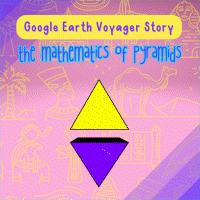
|
Google Earth Voyager Story: The Mathematics of Pyramids, Part 2 | Google Earth Voyager Story: The Mathematics of Pyramids, Part 2TopicGeometric Models |
Pyramids |
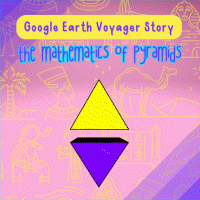
|
Google Earth Voyager Story: The Mathematics of Pyramids, Part 1 | Google Earth Voyager Story: The Mathematics of Pyramids, Part 1TopicGeometric Models |
Pyramids |
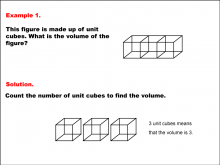
|
Math Example--Volume Concepts--Modeling Volume--Example 1 | Math Example--Volume Concepts--Modeling Volume--Example 1TopicVolume DescriptionThe image shows a rectangular prism made up of 3 unit cubes arranged in a single row. The example asks for the volume of the figure, and the solution involves counting the number of unit cubes. Example 1: The figure consists of 3 unit cubes. The caption reads: "Count the number of unit cubes to find the volume. 3 unit cubes means that the volume is 3." |
Volume |
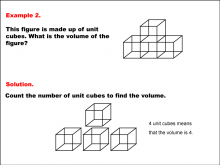
|
Math Example--Volume Concepts--Modeling Volume--Example 2 | Math Example--Volume Concepts--Modeling Volume--Example 2TopicVolume DescriptionThe image shows a figure made up of 4 unit cubes, with one cube stacked on top of another, forming an L-shape. The example asks for the volume, and the solution involves counting the cubes. Example 2: The figure consists of 4 unit cubes. The caption reads: "Count the number of unit cubes to find the volume. 4 unit cubes means that the volume is 4." |
Volume |
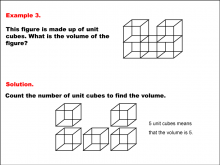
|
Math Example--Volume Concepts--Modeling Volume--Example 3 | Math Example--Volume Concepts--Modeling Volume--Example 3TopicVolume DescriptionThe image shows a figure made up of 5 unit cubes arranged in an irregular shape, with one cube raised above others. The example asks for the volume, and the solution involves counting the number of unit cubes. Example 3: The figure consists of 5 unit cubes. The caption reads: "Count the number of unit cubes to find the volume. 5 unit cubes means that the volume is 5." |
Volume |
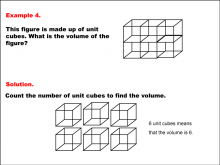
|
Math Example--Volume Concepts--Modeling Volume--Example 4 | Math Example--Volume Concepts--Modeling Volume--Example 4TopicFractions DescriptionThe image shows a rectangular prism made up of 6 unit cubes arranged in two layers (a top and bottom row). The example asks for the volume, and the solution involves counting all the cubes in both layers. Example 4: The figure consists of 6 unit cubes. The caption reads: "Count the number of unit cubes to find the volume. 6 unit cubes means that the volume is 6." |
Volume |
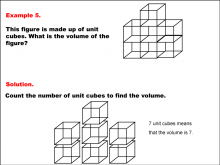
|
Math Example--Volume Concepts--Modeling Volume--Example 5 | Math Example--Volume Concepts--Modeling Volume--Example 5TopicFractions DescriptionThe image shows a 3D figure made up of unit cubes. The figure is stacked in a staggered manner, with some cubes placed directly on top of others. Below the figure, there is a breakdown showing the individual cubes counted to determine the volume. Example 5: The caption asks for the volume of the figure, which is made up of unit cubes. The solution involves counting the cubes to find the volume. |
Volume |

|
Google Earth Voyager Story: The Geometry of Sustainable Architecture, Part 1 | Google Earth Voyager Story: The Geometry of Sustainable Architecture, Part 1TopicGeometric Models |
Applications of Surface Area and Volume and Rational Functions and Equations |

|
Google Earth Voyager Story: The Geometry of Sustainable Architecture, Part 1 | Google Earth Voyager Story: The Geometry of Sustainable Architecture, Part 1TopicGeometric Models |
Applications of Surface Area and Volume and Rational Functions and Equations |

|
Google Earth Voyager Story: The Geometry of Sustainable Architecture, Part 2 | Google Earth Voyager Story: The Geometry of Sustainable Architecture, Part 2TopicGeometric Models |
Surface Area, Volume and Rational Functions and Equations |
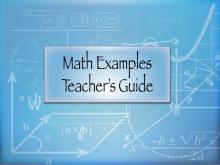
|
MATH EXAMPLES--Teacher's Guide: Volume | MATH EXAMPLES--Teacher's Guide: Volume
This set of tutorials provides 24 examples of how to find the volume of various 3-dimensional geometric figures. This is part of a collection of teacher's guides. To see the complete collection of teacher's guides, click on this link. Note: The download is a PDF file.Related ResourcesTo see resources related to this topic click on the Related Resources tab above. |
Volume |

|
Video Transcript: Algebra Applications: Rational Functions, Segment 2: Biology | Video Transcript: Algebra Applications: Rational Functions, Segment 2: Biology
This is the transcript for the video of same title. Video contents: All living things take up a certain amount of space, and therefore have volume. They also have a certain amount of surface area. The ratio of surface area to volume, which is a rational function, reveals important information about the organism. Students look at different graphs of these functions for different organisms. |
Rational Expressions and Rational Functions and Equations |

|
Video Transcript: Geometry Applications: 3D Geometry | Video Transcript: Geometry Applications: 3D Geometry
This is the transcript for the video of same title. Video contents: In this program we explore the properties of three-dimensional figures. We do this in the context of two real-world applications. In the first, we look at the three-dimensional structure of Mayan pyramids. These stair-step structures provide a unique opportunity to also explore sequences and series. In the second application we look at the Shanghai Tower as an example of cylindrically shaped structures. |
3-Dimensional Figures and Applications of 3D Geometry |

|
Video Transcript: Geometry Applications: 3D Geometry, Segment 1: Introduction | Video Transcript: Geometry Applications: 3D Geometry, Segment 1: Introduction
This is the transcript for the video of same title. Video contents: We visit ancient Greece to learn about the Platonic Solids. This provides an introduction to the more general topic of three-dimensional figures. This is part of a collection of video transcript from the Geometry Applications video series. To see the complete collection of transcripts, click on this link. Note: The download is a PDF file. Video Transcript LibraryTo see the complete collection of video transcriptsy, click on this link. |
3-Dimensional Figures and Applications of 3D Geometry |

|
Video Transcript: Geometry Applications: 3D Geometry, Segment 2: Pyramids | Video Transcript: Geometry Applications: 3D Geometry, Segment 2: Pyramids
This is the transcript for the video of same title. Video contents: Rectangular Prisms. Mayan pyramids are essentially stacks of rectangular prisms. The volume of each successive level is a percentage decrease of its lower neighbor. This introduces the notion of a geometric sequence and series, including an infinite series. |
3-Dimensional Figures and Applications of 3D Geometry |

|
Video Transcript: Geometry Applications: 3D Geometry, Segment 3: Cylinders | Video Transcript: Geometry Applications: 3D Geometry, Segment 3: Cylinders
This is the transcript for the video of same title. Video contents: The Shanghai Tower in China is a stack of cylindrical shapes, where each successive layer is a percentage decrease of its lower neighbor. As with the previous section, this introduces the notion of a geometric sequence and series. |
3-Dimensional Figures and Applications of 3D Geometry |

|
Video Transcript: Geometry Applications: Area and Volume | Video Transcript: Geometry Applications: Area and Volume
This is the transcript for the video of same title. Video contents: In this program we look at applications of area and volume. We do this in the context of three real-world applications. In the first, we look at the sinking of the Titanic in the context of volume and density. In the second application we look at the glass pyramid at the Louvre Museum and calculate its surface area. In the third application we look at the Citibank Tower in New York City to study the ratio of surface area to volume to learn about heat loss in tall buildings. |
Applications of Surface Area and Volume |

|
Video Transcript: Geometry Applications: Area and Volume | Video Transcript: Geometry Applications: Area and Volume
This is the transcript for the video of same title. Video contents: In this program we look at applications of area and volume. We do this in the context of three real-world applications. In the first, we look at the sinking of the Titanic in the context of volume and density. In the second application we look at the glass pyramid at the Louvre Museum and calculate its surface area. In the third application we look at the Citibank Tower in New York City to study the ratio of surface area to volume to learn about heat loss in tall buildings. |
Applications of Surface Area and Volume |

|
Video Transcript: Geometry Applications: Area and Volume | Video Transcript: Geometry Applications: Area and Volume
This is the transcript for the video of same title. Video contents: In this program we look at applications of area and volume. We do this in the context of three real-world applications. In the first, we look at the sinking of the Titanic in the context of volume and density. In the second application we look at the glass pyramid at the Louvre Museum and calculate its surface area. In the third application we look at the Citibank Tower in New York City to study the ratio of surface area to volume to learn about heat loss in tall buildings. |
Applications of Surface Area and Volume |

|
Video Transcript: Geometry Applications: Area and Volume | Video Transcript: Geometry Applications: Area and Volume
This is the transcript for the video of same title. Video contents: In this program we look at applications of area and volume. We do this in the context of three real-world applications. In the first, we look at the sinking of the Titanic in the context of volume and density. In the second application we look at the glass pyramid at the Louvre Museum and calculate its surface area. In the third application we look at the Citibank Tower in New York City to study the ratio of surface area to volume to learn about heat loss in tall buildings. |
Applications of Surface Area and Volume |

|
Video Transcript: Geometry Applications: Area and Volume | Video Transcript: Geometry Applications: Area and Volume
This is the transcript for the video of same title. Video contents: In this program we look at applications of area and volume. We do this in the context of three real-world applications. In the first, we look at the sinking of the Titanic in the context of volume and density. In the second application we look at the glass pyramid at the Louvre Museum and calculate its surface area. In the third application we look at the Citibank Tower in New York City to study the ratio of surface area to volume to learn about heat loss in tall buildings. |
Applications of Surface Area and Volume |

|
Video Transcript: Geometry Applications: Area and Volume | Video Transcript: Geometry Applications: Area and Volume
This is the transcript for the video of same title. Video contents: In this program we look at applications of area and volume. We do this in the context of three real-world applications. In the first, we look at the sinking of the Titanic in the context of volume and density. In the second application we look at the glass pyramid at the Louvre Museum and calculate its surface area. In the third application we look at the Citibank Tower in New York City to study the ratio of surface area to volume to learn about heat loss in tall buildings. |
Applications of Surface Area and Volume |

|
Video Transcript: Geometry Applications: Area and Volume | Video Transcript: Geometry Applications: Area and Volume
This is the transcript for the video of same title. Video contents: In this program we look at applications of area and volume. We do this in the context of three real-world applications. In the first, we look at the sinking of the Titanic in the context of volume and density. In the second application we look at the glass pyramid at the Louvre Museum and calculate its surface area. In the third application we look at the Citibank Tower in New York City to study the ratio of surface area to volume to learn about heat loss in tall buildings. |
Applications of Surface Area and Volume |

|
Video Transcript: Geometry Applications: Area and Volume | Video Transcript: Geometry Applications: Area and Volume
This is the transcript for the video of same title. Video contents: In this program we look at applications of area and volume. We do this in the context of three real-world applications. In the first, we look at the sinking of the Titanic in the context of volume and density. In the second application we look at the glass pyramid at the Louvre Museum and calculate its surface area. In the third application we look at the Citibank Tower in New York City to study the ratio of surface area to volume to learn about heat loss in tall buildings. |
Applications of Surface Area and Volume |

|
Video Transcript: Geometry Applications: Area and Volume, Segment 1: Volume and Density. | Video Transcript: Geometry Applications: Area and Volume, Segment 1: Volume and Density.
This is the transcript for the video of same title. Video contents: The sinking of the Titanic provides an opportunity to explore volume, density, and buoyancy. Students construct a mathematical model of the Titanic to determine why it sank and what could have been done to prevent it from sinking. |
Applications of Surface Area and Volume |

|
Video Transcript: Geometry Applications: Area and Volume, Segment 1: Volume and Density. | Video Transcript: Geometry Applications: Area and Volume, Segment 1: Volume and Density.
This is the transcript for the video of same title. Video contents: The sinking of the Titanic provides an opportunity to explore volume, density, and buoyancy. Students construct a mathematical model of the Titanic to determine why it sank and what could have been done to prevent it from sinking. |
Applications of Surface Area and Volume |

|
Video Transcript: Geometry Applications: Area and Volume, Segment 1: Volume and Density. | Video Transcript: Geometry Applications: Area and Volume, Segment 1: Volume and Density.
This is the transcript for the video of same title. Video contents: The sinking of the Titanic provides an opportunity to explore volume, density, and buoyancy. Students construct a mathematical model of the Titanic to determine why it sank and what could have been done to prevent it from sinking. |
Applications of Surface Area and Volume |

|
Video Transcript: Geometry Applications: Area and Volume, Segment 2: Surface Area. | Video Transcript: Geometry Applications: Area and Volume, Segment 2: Surface Area.
This is the transcript for the video of same title. Video contents: The glass-paneled pyramid at the Louvre Museum in Paris is a tessellation of rhombus-shaped glass panels. Students create a model of the pyramid to calculate the number of panels used to cover the surface area of the pyramid. |
Applications of Surface Area and Volume |

|
Video Transcript: Geometry Applications: Area and Volume, Segment 2: Surface Area. | Video Transcript: Geometry Applications: Area and Volume, Segment 2: Surface Area.
This is the transcript for the video of same title. Video contents: The glass-paneled pyramid at the Louvre Museum in Paris is a tessellation of rhombus-shaped glass panels. Students create a model of the pyramid to calculate the number of panels used to cover the surface area of the pyramid. |
Applications of Surface Area and Volume |

|
Video Transcript: Geometry Applications: Area and Volume, Segment 2: Surface Area. | Video Transcript: Geometry Applications: Area and Volume, Segment 2: Surface Area.
This is the transcript for the video of same title. Video contents: The glass-paneled pyramid at the Louvre Museum in Paris is a tessellation of rhombus-shaped glass panels. Students create a model of the pyramid to calculate the number of panels used to cover the surface area of the pyramid. |
Applications of Surface Area and Volume |

|
Video Transcript: Geometry Applications: Area and Volume, Segment 2: Surface Area. | Video Transcript: Geometry Applications: Area and Volume, Segment 2: Surface Area.
This is the transcript for the video of same title. Video contents: The glass-paneled pyramid at the Louvre Museum in Paris is a tessellation of rhombus-shaped glass panels. Students create a model of the pyramid to calculate the number of panels used to cover the surface area of the pyramid. |
Applications of Surface Area and Volume |

|
Video Transcript: Geometry Applications: Area and Volume, Segment 3: Ratio of Surface Area to Volume | Video Transcript: Geometry Applications: Area and Volume, Segment 3: Ratio of Surface Area to Volume
This is the transcript for the video of same title. Video contents: The Citibank Tower in New York City presents some unique design challenges. In addition it has to cope with a problem that all tall structure have to deal with: heat loss. By managing the ratio of surface area to volume, a skyscraper can effective manage heat loss. |
Applications of Surface Area and Volume |

|
Video Transcript: Geometry Applications: Area and Volume, Segment 3: Ratio of Surface Area to Volume | Video Transcript: Geometry Applications: Area and Volume, Segment 3: Ratio of Surface Area to Volume
This is the transcript for the video of same title. Video contents: The Citibank Tower in New York City presents some unique design challenges. In addition it has to cope with a problem that all tall structure have to deal with: heat loss. By managing the ratio of surface area to volume, a skyscraper can effective manage heat loss. |
Applications of Surface Area and Volume |

|
Video Transcript: Geometry Applications: Area and Volume, Segment 3: Ratio of Surface Area to Volume | Video Transcript: Geometry Applications: Area and Volume, Segment 3: Ratio of Surface Area to Volume
This is the transcript for the video of same title. Video contents: The Citibank Tower in New York City presents some unique design challenges. In addition it has to cope with a problem that all tall structure have to deal with: heat loss. By managing the ratio of surface area to volume, a skyscraper can effective manage heat loss. |
Applications of Surface Area and Volume |

|
Video Transcript: Geometry Applications: Area and Volume, Segment 3: Ratio of Surface Area to Volume | Video Transcript: Geometry Applications: Area and Volume, Segment 3: Ratio of Surface Area to Volume
This is the transcript for the video of same title. Video contents: The Citibank Tower in New York City presents some unique design challenges. In addition it has to cope with a problem that all tall structure have to deal with: heat loss. By managing the ratio of surface area to volume, a skyscraper can effective manage heat loss. |
Applications of Surface Area and Volume |
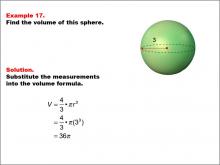
|
Math Example--Volume Concepts--Calculating Volume: Example 17 | Math Example--Volume Concepts--Calculating Volume: Example 17TopicVolume DescriptionA green sphere with a radius labeled as 3. The image is part of a math example showing how to calculate the volume of a sphere. This image illustrates Example 17: The text describes finding the volume of a sphere. The formula used is V = (4/3) * π * r3, where r = 3. After substituting, the result is V = 36π. Volume is a fundamental concept in geometry that helps students understand the space occupied by three-dimensional objects. In this collection, each example uses various geometric shapes to calculate volume, showcasing real-life applications of volume in different shapes. |
Volume |
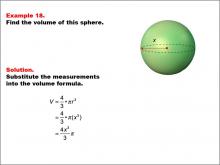
|
Math Example--Volume Concepts--Calculating Volume: Example 18 | Math Example--Volume Concepts--Calculating Volume: Example 18TopicVolume Description
A green sphere with a radius labeled as x. This image is part of a math example showing how to calculate the volume of a sphere using an unknown radius. This image illustrates Example 18: The text explains how to find the volume of a sphere with an unknown radius x. The formula used is V = (4/3) * π * r3, and substituting r = x gives V = (4/3) * x3 * π. |
Volume |

|
Math Example--Volume Concepts--Calculating Volume: Example 19 | Math Example--Volume Concepts--Calculating Volume: Example 19TopicVolume Description
A green cube with side length labeled as 7. The image illustrates how to calculate the volume of a cube with known side length. This image illustrates Example 19: The text describes finding the volume of a cube. The formula used is V = s3, where s = 7. After substituting, the result is V = 343. Volume is a fundamental concept in geometry that helps students understand the space occupied by three-dimensional objects. In this collection, each example uses various geometric shapes to calculate volume, showcasing real-life applications of volume in different shapes. |
Volume |
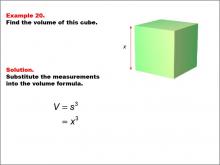
|
Math Example--Volume Concepts--Calculating Volume: Example 20 | Math Example--Volume Concepts--Calculating Volume: Example 20TopicVolume DescriptionA green cube with side length labeled as x. This image is part of a math example showing how to calculate the volume of a cube using an unknown side length. This image illustrates Example 20: The text explains how to find the volume of a cube with an unknown side length x. The formula used is V = s3, and substituting s = x gives V = x3. |
Volume |
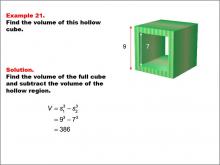
|
Math Example--Volume Concepts--Calculating Volume: Example 21 | Math Example--Volume Concepts--Calculating Volume: Example 21TopicVolume DescriptionA hollow cube with an outer edge of 9 and an inner hollow region with an edge of 7. The image shows how to calculate the volume by subtracting the volume of the inner cube from the outer cube. This image illustrates Example 21: Find the volume of a hollow cube. The formula used is V = s13 - s23, where s1 is the outer edge (9) and s2 is the inner edge (7). The solution calculates 9^3 - 7^3 = 386.. |
Volume |
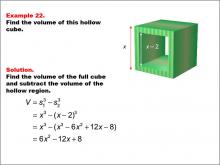
|
Math Example--Volume Concepts--Calculating Volume: Example 22 | Math Example--Volume Concepts--Calculating Volume: Example 22TopicVolume DescriptionA hollow cube with an outer edge of x and an inner hollow region with an edge of x - 2. The image shows how to calculate the volume by subtracting the volume of the inner cube from the outer cube. This image illustrates Example 22: Find the volume of a hollow cube. The formula used is V = s13 - s23, where s1 = x and s2 = x - 2. Expanding and simplifying gives V = 6x2 - 12x + 8. |
Volume |
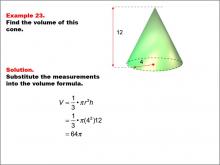
|
Math Example--Volume Concepts--Calculating Volume: Example 23 | Math Example--Volume Concepts--Calculating Volume: Example 23TopicVolume Description
A cone with a height of 12 and a radius of 4. The image shows how to calculate its volume using the cone volume formula (V = 1/3 * π * r2 * h). This image illustrates Example 23: Find the volume of a cone. The formula used is V = (1/3) * π * r2 * h, where r = 4 and h = 12. Substituting these values gives V = (1/3) * π * (42) * 12 = 64π. |
Volume |